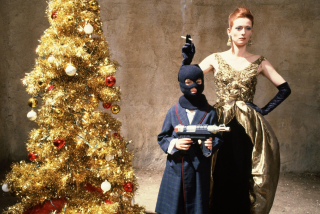A certain flow powers ‘The River’
- Share via
JEAN RENOIR had been directing for nearly 30 years before he made a movie in color. But the result -- 1951’s “The River” -- was not only worth the wait, it kicked off a new creative era in the French director’s career. After “The River,” he directed three more lush color films during the decade: “The Golden Coach,” “French Cancan” and “Elena and the Men.”
A new print of “The River,” recently restored by the Academy Film Archive in association with the British Film Institute, Janus Films and the Film Foundation and funded with support from the Hollywood Foreign Press Assn., will screen Wednesday at the Academy of Motion Picture Arts and Sciences’ Samuel Goldwyn Theater. The restored print premiered last year at the Cannes Film Festival.
Shot on location in India -- the film was photographed by his nephew Claude Renoir -- “The River” revolves around three young girlfriends living in the country along the Ganges River who vie for the affection of a wounded American captain. Renoir and Rumer Godden penned the screenplay, based on the novel by Godden.
According to Renoir, “The River” had no “apparent plot, but an intense, may we say, ‘inner action.’ ”
The story was dear to him because he’d long been fascinated with water. The son of Impressionist painter Pierre Auguste Renoir, the director spent his childhood days on the rivers of France. “I cannot conceive of cinema without water,” Renoir said in the book “Jean Renoir: Projections of Paradise” by Ronald Bergen. “There is an escapable quality in the movement of a film which relates to the ripple of streams and the flow of rivers.”
“The River” is considered one of the great achievements in the use of three-strip Technicolor, skillfully capturing the countryside of India as well as the colorful characters who inhabit the area.
“The palette is so deliberate and structured in a way that it adds to the narrative itself,” says Mike Pogorzelski, director of the Academy Film Archive.
It wasn’t easy shooting in the Technicolor process in India in the early 1950s. Not only were the cameras big, clumsy and sensitive to heat and terrain changes, there was no place locally to process the film.
“The closest laboratory was in London,” says Pogorzelski. “So they would shoot for a week or two at a time and then send the negatives to London to be developed and printed and then another week to have it returned to them. [By then] they were already four to six weeks ahead in the schedule before they saw their first daily. So it was a Technicolor nightmare.”
Renoir had difficulty obtaining financing for “The River,” Pogorzelski says, because Godden’s novel “was deemed not story-worthy or filmable by all the studios because there were no Bengal tigers or lancers -- the kind of thing you were used to seeing in an ‘Indian film.’ ”
In the end, the money came from a Hollywood-based florist named Kenneth McEldownery. His wife, a publicist at MGM studios, dared him to make a movie after he complained about the quality of one of her studio’s films. He sold their home and floral shop and produced “The River.” Though the film made $16 million worldwide -- including a then-record 34-week, reserved-seat engagement in New York -- McEldownery never produced another film. He went into real estate.
It was Indian film master Satyajit Ray who introduced Renoir to India when the French director made his first visit to the country.
“One of the things Renoir said was that if he was going to make the film, he would need to go over and get to know India,” says Pogorzelski. “Ray was kind of his guide physically through the country but also through Indian art and music. They got to be very close that way. It has been told and retold by both men that Renoir was the one who encouraged Ray to make his first film, ‘Pather Panchali.’ ”
The restoration of “The River” took about nine months. “We were fortunate that the three-strip Technicolor nitrate camera negatives had been at the BFI for many years,” says Josef Linder, preservation officer on the project.
Though nitrate stock is unstable and can quickly deteriorate, the camera negative was in remarkably good shape. “We were so fortunate that there was no deterioration or shrinkage or missing pieces,” says Linder.
The original soundtrack negative was a different matter -- it didn’t exist. But there was a print of the film in director Martin Scorsese’s personal collection that, according to Linder, was “flawless. The entire soundtrack restoration came from that one print. There were other sources, but his was the best and entirely complete.”
*
‘The River’
Where: Academy of Motion Picture Arts and Sciences, Samuel Goldwyn Theater, 8949 Wilshire Blvd., Beverly Hills
When: 8 p.m. Wednesday
Price: $5
Contact: (310) 247-3600
or www.oscars.org
More to Read
Only good movies
Get the Indie Focus newsletter, Mark Olsen's weekly guide to the world of cinema.
You may occasionally receive promotional content from the Los Angeles Times.









